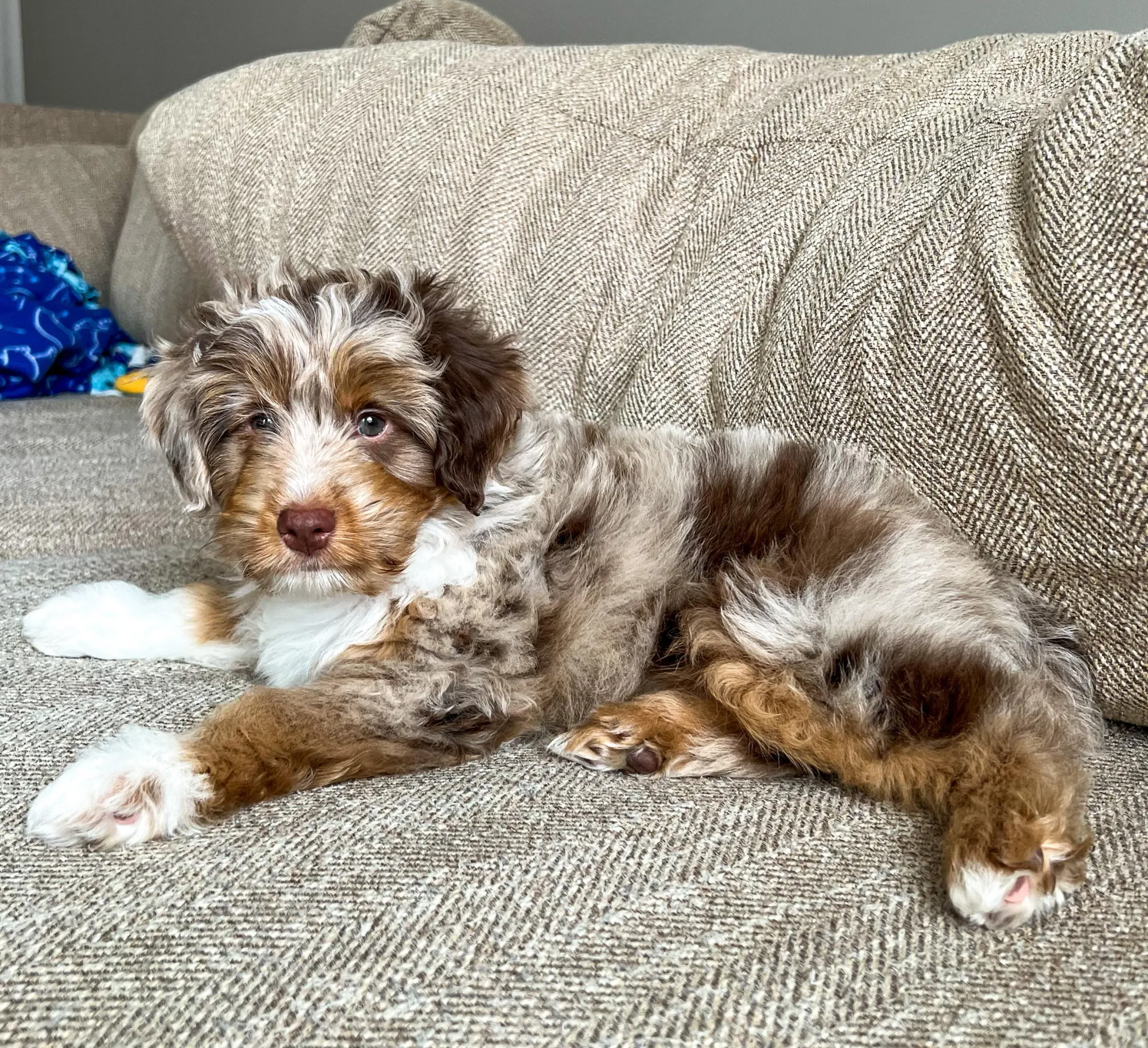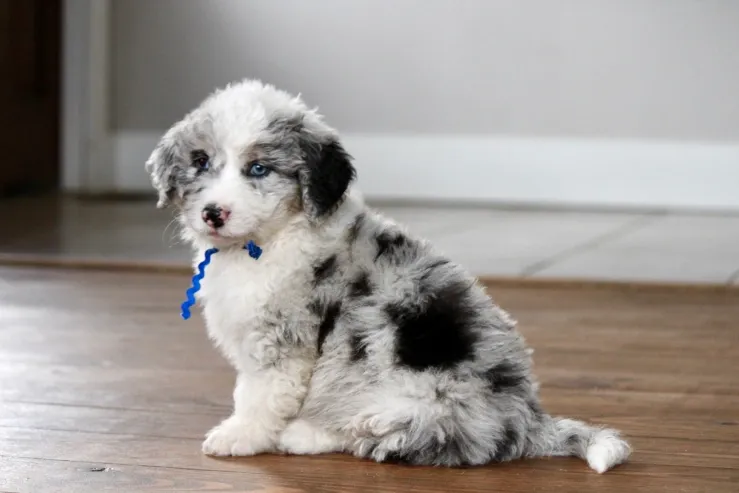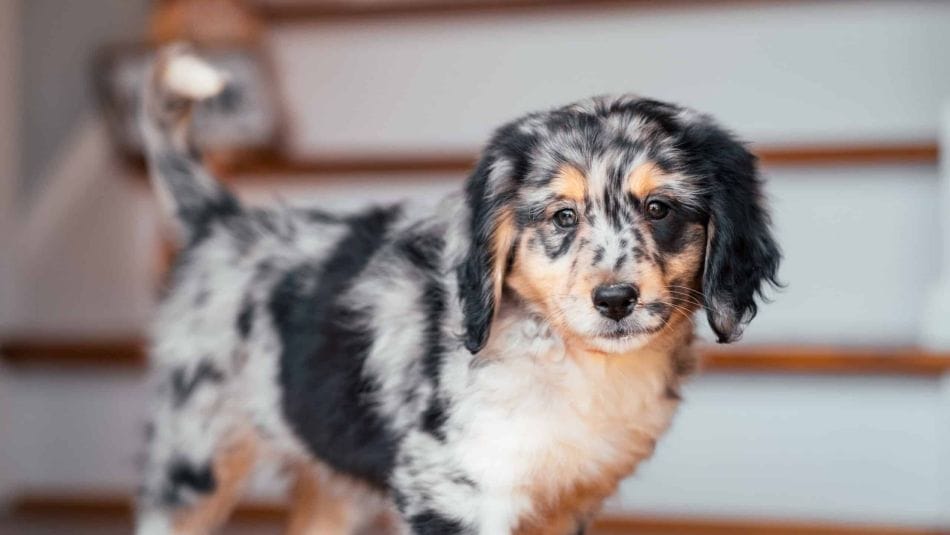Aussiedoodles are a popular hybrid breed, a cross between the Poodle and the Australian Shepherd. This mixed breed inherits traits from both parent breeds, which influence their physical characteristics, including their coat, build, and tails. Like many canines, Aussiedoodles naturally have tails which come in various shapes and sizes and often reflect the genetic influence of their parents.

The tail of an Aussiedoodle can vary depending on the dominant breed traits it inherits. Poodles are known for their curly hair and often have docked tails, a practice that is becoming increasingly controversial and is illegal in some countries. Australian Shepherds, on the other hand, may sometimes be born with naturally bobbed tails or have full, plume-like tails that are expressive and in motion. Consequently, an Aussiedoodle may have a tail that is long and feathered, short and curly, or even naturally short, depending on which genes are more prevalent from the parent breeds.
When considering the tail of an Aussiedoodle, it's essential to understand that docking or leaving the tail in its natural state can affect the dog's appearance and communication with other dogs and people. They communicate a lot through their tails, using them to express emotions ranging from excitement to apprehension. Thus, while Aussiedoodles do have tails, the specific characteristics of each individual's tail will depend on their unique genetic makeup and the breeding practices employed.

Understanding the Aussiedoodle
The Aussiedoodle is a hybrid dog, a cross between the Poodle and the Australian Shepherd. They are considered a mixed breed with the intelligence and hypoallergenic coat of the Poodle, along with the energetic and friendly disposition of the Australian Shepherd.
Characteristics
Origin: Hybrid (Poodle X Australian Shepherd)
Size: Varies
Coat: Typically curly or wavy
Color: Wide range
Aussiedoodles are known for their playful and affectionate nature, making them ideal for families. Their coats are often a mix of their parents' colors and patterns. The breed takes advantage of the Poodles' minimal shedding trait, making them suitable for individuals with allergies.
Intelligence and Training
Aussiedoodles are highly intelligent and trainable. Their Australian Shepherd heritage ensures they are energetic and require ample stimulation; they thrive on challenges.
Generations and Breeding
Breeders may categorize Aussiedoodles into generations such as F1, F1B, F2, etc., indicating the mix of Australian Shepherd and Poodle heritage.
Health and Puppies
Prospective owners should seek reputable breeders who test for genetic issues. Aussiedoodle puppies should be socialized early to ensure they develop well-rounded temperaments.
Physical Characteristics of Aussiedoodles
Aussiedoodles exhibit a blend of traits from their Australian Shepherd and Poodle forebears. They boast distinct coats often considered hypoallergenic and come in a range of sizes with proportionate tails.
Coat and Grooming
Aussiedoodles have a variety of coat types, ranging from wavy to curly, akin to the Poodle's hypoallergenic fur, or straighter like the Australian Shepherd's. Their fur requires regular maintenance:
- Brushing at least two to three times a week to prevent matting.
- Bathing every few weeks or when necessary, taking care not to strip natural oils.
They typically exhibit low to non-shedding qualities, making them popular among people with allergies.
Tail Features
Aussiedoodles possess tails that are proportional to their body size. Their tails can be:
- Straight or slightly curved.
- Often left natural, but sometimes docked in countries where it is legally permitted.
Size and Weight
Aussiedoodles vary in size, primarily determined by the size of the Poodle parent. There are generally three categories:
- Standard: Weighs between 40 to 70 pounds, with a height of 15 to 25 inches.
- Miniature: Weighs between 15 to 35 pounds, with a height of 10 to 15 inches.
- Toy: The smallest variation, typically weighing less than 15 pounds and standing no more than 10 inches in height.
Their weight and height should be proportionate, contributing to a balanced and harmonious appearance.
Tail Docking Practices
In the context of Aussiedoodles, tail docking involves removing part of a dog's tail. This practice varies greatly depending on legal regulations and breed standards.
History of Tail Docking
Tail docking has been a common practice in dog breeding for centuries. Initially, it was believed to prevent injuries among working dogs and to convey a certain aesthetic appeal. Breed standards for certain types often included a docked tail as a desirable trait, particularly in breeds such as the Australian Shepherd, which contributes to the Aussiedoodle's lineage. Over time, what was once a practical approach shifted, with cosmetics playing a larger role in tail docking decisions.
Tail Docking and the Law
The legality of tail docking varies around the world. In many countries, the practice is considered illegal when performed purely for cosmetic reasons. Legislation aims to protect animals from unnecessary procedures that do not provide a medical benefit.
| Region | Legal Status | Remarks |
|---|---|---|
| European Union | Largely Illegal | Exceptions for certain breeds and working dogs |
| Australia | Varied by state | Some ban it, others allow with restrictions |
| United States | Legal | Subject to state laws, with some restrictions |
It is important for breeders to comply with local laws to avoid penalties and ensure animal welfare. Some breed clubs have modified their breed standards to discourage tail docking, reflecting a shift in societal values towards the natural appearance of dogs. Docked tails may still be seen among Aussiedoodles, but many are choosing to leave their dogs' tails intact, focusing on the health and natural characteristics of the breed rather than traditional aesthetics.

Aussiedoodles in the Home and Family
Aussiedoodles typically exhibit a pleasing blend of loyalty and affection, making them suitable companions for home life and integration into the family dynamic.
Behavior and Temperament
Aussiedoodles are known for their intelligent and friendly nature, which often translates into a trainable and adaptable temperament. They are active dogs that thrive on regular exercise and mental stimulation to maintain their well-being. This breed's high intelligence level means they learn commands quickly, but also require consistent stimulation to prevent boredom. It is essential for families to engage their Aussiedoodle in activities that challenge them both physically and mentally.
- Traits: Loyal, loving, and energetic
- Needs: Daily exercise and mental challenges
- Suitability: Great for active families
Interaction With Children and Pets
Aussiedoodles generally have a loving disposition towards children, exhibiting patience and playfulness. Their loyal nature makes them attentive companions, and they can integrate well with families when socialized properly from a young age. With pets, Aussiedoodles can coexist peacefully, especially when introduced correctly and if they grow up together. Proper introduction techniques and supervision during initial interactions help ensure a smooth integration within the family's pet dynamics.
- Children: Playful and patient
- Other Pets: Usually friendly with proper introduction
- Note: Supervision is advised during initial interactions
Training and Mental Stimulation
Aussiedoodles, the crossbreed between Australian Shepherds and Poodles, are known for their intelligence and high energy levels. This blend of traits demands consistent training and ample mental stimulation for maintaining their well-being.

Obedience Training: They respond well to training, which should start early. A structured routine and clear commands facilitate their ability to learn quickly and develop balance and agility. Training also strengthens communication between the dog and its owner, establishing a harmonious relationship.
- Commands: Start with basic commands like sit, stay, and come.
- Consistency: Training should be consistent to help them learn effectively.
Mental Stimulation: Due to their sharp intellect, mental exercises are crucial to prevent boredom and potential destructive behavior.
- Puzzle Toys: Engage their mind with interactive toys that challenge their problem-solving skills.
- Hide and Seek: Stimulate their herding instincts with games that require them to search and retrieve.
Exercise for Agility: Aussiedoodles benefit from activities that cater to their agility and herding heritage.
- Obstacle Courses: They enjoy and excel in navigating through obstacle courses, which provide them with physical and mental challenges.
- Fetch: A game of fetch not only exercises their body but also their ability to focus and follow commands.
In summary, the key to raising a well-balanced Aussiedoodle is a combination of routine training and diverse mental stimulation, designed to harness their intelligence and natural strengths in herding and agility. Engaging regularly in such activities will ensure they are not only physically active but mentally satisfied.
Exercise and Health Considerations
Aussiedoodles often inherit the high energy levels typical of their parent breeds. They require consistent, daily exercise to maintain their health and prevent behavioral issues. It's important for owners to be aware of the exercise needs of these active dogs, as well as common health issues that may arise.
Exercise Needs
The Aussiedoodle is a cross between an Australian Shepherd and a Poodle, both of which are high-energy, active dog breeds. Given their parentage, they typically exhibit similar traits and require substantial exercise to match their energy levels.
- Daily activity: At least 60 minutes per day.
- Types of exercise:
- Walks: Brisk, long-distance walks.
- Play: Interactive games such as fetch.
- Mental stimulation: Puzzle toys and training sessions.
These activities not only keep their body fit but also provide the mental stimulation that these intelligent dogs need. It is also notable that Aussiedoodles have a herding instinct inherited from the Australian Shepherd side, making them well-suited for activities that mimic working dog tasks.
Common Health Issues
While generally healthy, Aussiedoodles may be predisposed to certain health issues that prospective owners should be aware of.
- Genetic predispositions:
- Hip dysplasia
- Elbow dysplasia
Ensuring regular veterinary check-ups and maintaining a proper diet will help manage these potential health concerns. Owners should pay attention to their Aussiedoodle's tail, whether it's a long tail or a short tail, for any signs of injury, as their exuberant movements can sometimes lead to accidents. Regular exercise also plays a crucial role in preventing obesity, which can exacerbate these health issues.
Aussiedoodle Maintenance and Care
Aussiedoodle owners should prioritize grooming and hygiene to maintain their pet's health. Regular maintenance ensures a happy, clean, and healthy dog.
Grooming Needs
Fur and Coat: The Aussiedoodle has a unique coat that can range from wavy to curly, which requires consistent care. Owners should brush their Aussiedoodle's fur at least three times a week to prevent matting and tangles. Using a slicker brush or a wide-toothed comb can be effective for this breed's fur. Periodic trimming, especially around the eyes and paws, keeps their coat in good shape.
Professional Grooming: At least every 8-12 weeks, consider a professional grooming session. This helps manage the coat length and maintains the overall health of the fur, minimizing the chances of skin infections.
Hygiene and Cleaning
Nails: Regular nail trims are essential to prevent discomfort and structural issues. A bi-weekly nail check is recommended, with trimming as needed.
Eyes and Ears: Routine checks of the eyes and ears can identify early signs of irritation or infection. Cleaning the ears weekly helps prevent ear infections, a common issue in Aussiedoodles.
Teeth: Dental hygiene is key to prevent bad breath and dental diseases. Brush their teeth several times a week with dog-specific toothpaste.
General Cleanliness: Owners should wipe their Aussiedoodle's paws and underbelly after outdoor play to prevent the spread of dirt and fecal matter into the home. Bathing the dog every 4-6 weeks keeps their coat and skin clean and reduces the likelihood of infections.

Choosing an Aussiedoodle
When considering adding an Aussiedoodle to your family, it's important to think carefully about both the source of your new pet and the characteristics of the breed. This involves understanding the diversity within the breed and ensuring that you are working with reputable breeders or adoption centers.
Breeders and Adoption
Reputable Breeders: Potential Aussiedoodle owners should seek breeders who uphold high standards, often endorsed by organizations like the American Kennel Club (AKC). Breeders should practice selective breeding to ensure the health and well-being of the offspring. A trustworthy breeder will:
- Have a strong knowledge of the breed
- Provide health clearances for both parent dogs
- Allow you to visit and observe the puppies and their living conditions
Adoption Options: For those looking to adopt, rescues and shelters may have Aussiedoodles or mixed breeds available. Adoption is a conscientious choice, offering a home to a dog in need. Important considerations for adoption include:
- The dog's history and temperament
- Any known health issues
- The support offered by the adoption agency post-adoption
Breed Standards and Variations
Breed Standards: The Aussiedoodle is not officially recognized by the AKC as a breed standard given its status as a hybrid dog (a mix between an Australian Shepherd and a Poodle). However, breed enthusiasts recognize the importance of maintaining certain characteristics:
- Size variations (Standard, Miniature, and Toy)
- Coat colors and patterns, such as blue merle, which is highly sought after
Size and Type:
| Size Type | Poodle Type | Expected Height | Expected Weight |
|---|---|---|---|
| Standard | Standard Poodle | 20-24 inches | 40-70 lbs |
| Miniature | Mini Aussiedoodle | 12-19 inches | 15-35 lbs |
| Toy | Toy Poodle | Under 12 inches | 4-12 lbs |
Owners should understand the physical and temperamental variations that selective breeding can produce, enabling them to choose a dog that complements their lifestyle and living conditions efficiently.
Frequently Asked Questions
In this section, readers will find answers to common inquiries regarding the physical characteristics and care considerations for Aussiedoodles, specifically focusing on their tails.

Q1: Are the tails of Aussiedoodles naturally short or are they docked?
Aussiedoodles typically have long tails that are expressive and in motion when they are active. Docking, or surgically removing portions of an animal's tail, is a practice that varies by breeder and is not inherent to the breed.
Q2: What is the typical appearance of an Aussiedoodle's tail?
The tail of an Aussiedoodle is normally fluffy and may have a slight curve. It reflects the breed's mix, displaying traits from both the Australian Shepherd and the Poodle, which can result in variations from one dog to another.
Q3: How can I distinguish an Aussiedoodle from other doodle breeds?
Aussiedoodles may be identified by their unique coat colors and patterns, such as the merle pattern, which is common in Australian Shepherds. Their tails are also usually longer and more expressive than some other doodle breeds.
Q4: Do Aussiedoodles generally have issues with shedding?
Aussiedoodles are often celebrated for their low-shedding coats, which make them popular among people with allergies. However, shedding can vary based on their genetic mix, with some shedding minimally and others more substantially.
Q5: Is it common for Aussiedoodles to retain their dewclaws?
Aussiedoodles may have their dewclaws intact, but some breeders choose to remove them. Whether they retain their dewclaws can depend on the breeder's practices and whether the dog is intended for pet or working purposes.
Q6: What are the grooming needs for an Aussiedoodle's tail, especially if it's curly?
Curly-tailed Aussiedoodles require regular grooming to prevent mats and tangles. This typically involves brushing several times a week and occasional trimming to keep the tail neat and tidy.